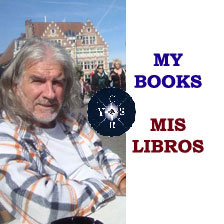PART TWO
FROM JUBAL' TO BORUS'S HARP
I.
THE HARP IN THE BIBLE
“The cherubic
host in thousand quires
Touch their immortal harps of golden wires”.
—Milton.
Jubal’s harp. Egyptian influence. The kinnor and nebel.
The harp associated with prophesying. Harps in Solomon’s Temple.
Jewish instruments. The New Jerusalem. Early Christian worship.
Music school at Rome under St. Leo.
The “music of the spheres”, as understood by the pagan
philosophers, finds its analogue in that beautiful passage from
the Book of Job, wherein we read that “the morning stars sang together, and
all the sons of God shouted for joy”. In the fourth chapter of the
Book of Genesis it is stated that Jubal, son of Lamech (seventh
in descent from, yet contemporaneous with, Adam), was “the father
of them that play upon the harp (kinnor) and the organ (ugab)”.
Whilst the Lutheran version reads “fiddlers and pipers”, the Revised
Version more correctly gives “harp and pipe”.
About the year B.C. 1730 there is mention made of serenading
distinguished visitors “with joy, and with songs, and with timbrels
(toph), and with harps (kinnor)”, as is recorded in Genesis (xxx.
27). The kinnor (said to have been the prototype of the trigon
or trigonon) has been equated with cithara or harp, and had from
eight to ten strings, resembling the Irish cruit, or ocht-tedach.
Although Josephus says that the kinnor was played with a plectrum,
the Bible credits David with playing on it “with his hand” (1 Kings
xvi. 23). One of the most pathetic passages in the Old Testament
is the description of the Israelites by the waters of Babylon hanging
their harps on the willow-trees. They could not tune their kinnors,
nor could they sing the songs of Israel in a strange land.
Some authorities equate the nebel, or nebelazor, of the
Bible with a form of harp, but it is more probable that it was a
psaltery. At the same time, it is only right to add that strong
arguments have been adduced to prove the nebel to have been a large
form of the kinnor, somewhat like the clairseach.
De Sola gives us what purports to be the veritable melody
which was sung by Miriam and her companions (Exodus xv. 21,
22), but it is agreed by most scholars that this antiphon, rendered
as it was by two millions of voices in unison, to the accompaniment
of timbrels and dances, was more or less an adaptation of Egyptian
music.
It is natural to suppose that the intercourse for four
hundred years in Egypt materially influenced the music of the Israelites. Music
in Egypt was so intimately bound up with the temple that it was
almost exclusively a sacred art, for, as is testified by Ranke,
religion dominated over all, and there was little of the secular
element permitted. Presided over by the priests, the sacred songs
and melodies were most jealously guarded, and no innovations were
allowed, as can be gathered from Plato. However, the wanderings
of the Children of Israel through the desert, and the succeeding
five hundred years of strife with neighbouring nations, left the
chosen people in a rather primitive condition as regards music.
There seems to have been a most intimate connection between
the harp and the gift of prophecy. We read that the company of prophets whom
Saul met “coming down from the high place with a psaltery,
and a timbrel, and a pipe, and a harp before them”, were found prophesying;
and that Saul himself, smitten with the same spirit, prophesied
among them (1 Kings x. 5-10). Again, the prophet Elias, fairly excited
with holy zeal, ordered a musician to be brought to calm his soul;
and “when the minstrel played, the hand of the Lord came upon him,
and he obtained favours in abundance” (4 Kings III. 13-15). The
royal prophet, too, illustrates the intimate connection between
music and prophecy when he says, “I will open my dark saying upon
the harp” (Psalms XLIX. 4).
David, before his death, gave the most minute directions
to Solomon regarding the building of the Temple and its adornment,
with special reference to the musical arrangements. He himself is
known to have played on the psaltery and the harp.
In Solomon’s Temple the music was on a most colossal
scale, and even the Albert Hall choirs pale into insignificance before the monster
choral services associated with this glorious building. Foreign
workmen were employed for the finer and more delicate portions,
as well as to make special instruments: “And the King made of the
thyme trees [almug-tress, or sandal-wood] the rails of the house
of the Lord, and of the King’s house, and citterns and harps for
singers” (3 Kings x. 12). It almost reads like a legend what
is told of the Temple services, and of the 200,000 priests, with
trumpets, and 40,000 harps and psalteries. Not only were there
4000 Levites to sing praises to the Lord with instrumental accompaniment,
but we read that there were 288 trained singers, who sang beside
the altar to the harp and other instruments.
The dedication of the wall of Jerusalem took place, as
Nehemiah tells us, “with singing, and with cymbals and psalteries
and harps”. In fact, music was as essential to religious celebrations
with the Jews as with the Egyptians. But,
alas! very little is actually known of even the shape of the Jewish
instruments, as not a single bas-relief exists by which we can accurately
judge. We can only assume that the Hebrews used the same instruments
as the Egyptians and Assyrians and Chaldeans, from whom they derived
their musical system. Herod rebuilt the Temple, B.C. 25, but it
was utterly razed under Titus, when the harp was ever after silent.
In the Book of Revelation St. John tells us that the
mighty choral praise of the elect in the New Jerusalem will have
a grand accompaniment of multitudinous harps, for ever proclaiming
the greatness of Him whose mercy endureth for ever
For the first four centuries of the Christian era there
could have been no ornate musical services, owing to the persecutions.
It is now agreed that the early Christian music was an amalgam of
simple melodies with the adapted psalmody and sacred songs from
the Temple of Jerusalem. It is reasonable to believe that the harp
was for a time used by the converted Jews, as it was the policy
of the early Church to allow a free hand in matters of discipline,
and, of course, the traditions of the Temple were very dear, especially
the antiphonal chanting of the psalms. Greek-art, of necessity,
was a factor in the liturgic chants, as also Roman art, and so the
evolution of sacred music proceeded, culminating in the foundation
of a music school at Rome, by Pope St. Leo, in the year 460.
In the orchestra sculptured in high relief in the Portico della Gloria of Santiago de Compostela,
in Spain, there are twenty-four life-size figures, representing
the twenty-four elders seen by St. John in the Apocalypse. As these
figures were executed in 1188 (as stated on the inscribed lintel),
they are specially interesting, and there are harps, psalteries,
cruits, and viols in evidence.
| PORTICO
DE LA GLORIA |
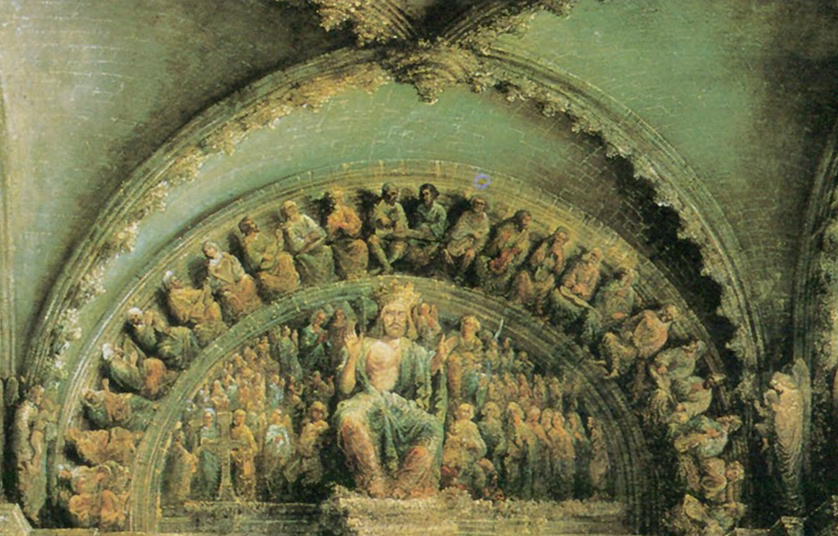 |
II.
THE IRISH HARP
Singing to the harp in ancient Ireland. The last Feis
of Tara. St. Columcille. The ceis. Clarisech and fidil in the seventh
century. Irish monasteries in England. “Glastonbury of the Irish”.
Sculptured Irish harps of the ninth century. A band of harps. The
Irish monks of St. Gall. Alfred the Great. St. Dunstan’s Aeolian
harp. Ilbrechtach the Harper.
As early as the sixth century Irish ecclesiastics were
wont to sing psalms and hymns to the accompaniment of the cruit
or small harp. This custom continued for seven centuries, as Giraldus
Cambrensis (as late as 1190) tells of the bishops and abbots “who
travelled about with their harps”, utilising their instrumental
powers as a means of gaining converts. Giraldus also alludes to
St. Kevin’s (sixth century) harp.
In the same century we read of a famous Feis (gathering)
at which over a thousand bards were present. All readers have heard
of “Tara’s halls”, but it is not as generally known that the great
Feis, or Parliament of Tara, was held triennially (O'Donovan says
septennially) by the chief monarch of Ireland. The Feis of
Tara, Co. Meath, was a representative assemblage of the men of Erin,
who met on the third day before the feast of Samhain—the first of
November—and ended the third day after it. When the business of
each day was concluded there was minstrelsy in the banquet hall.
The last Feis of Tara was in 560, under the presidency of Dermot
mac Fergus, Head King of Ireland, the founder of Clonmacnoise. In
that year it was cursed by St. Ruadhan of Lorrha, and never more
was the harp heard in Tara’s halls.
There is an interesting reference to the cruit in the
Life of St. Columcille, by St. Eunan (Adamnan),
as follows: — “On one occasion as St. Columcille
was seated with some disciples on the banks of Loch Cé [near Boyle,
Co. Roscommon], a bard came up to him and entered into conversation
with the little band of monks. When the poet-minstrel had departed,
the disciples of St. Columcille asked: '’Why did you not ask the
bard Cronan to sing a song for us to the accompaniment of his harp
[cruit], as poets are wont to do?’.”
In an ancient eulogy of St. Columcille, who died in 596,
we read of a “song of the cruit without the ceis”; that is, a harp-melody
without the harp-fastener (ceis), or an air played on an untuned
harp. About this time the cruit had a formidable rival in a larger
form of harp called the clairsech, the festive or heroic harp of
mediaeval Erin.
For centuries the general name of the harp in Ireland
has been clairsech, and the Irish brought the instrument to Scotland
at the close of the sixth century, where it has ever since been
known by the same name. It is remarkable that the parent
of the modern violin also hails from Ireland. Certain it is that
the fidil, or fiddle, is alluded to in an authentic Irish manuscript
of the seventh century, known as the “Fair of Carman”. Fidil, in
Irish, means a little bent rod, or bow, from the root fid=a rod,
and the instrument was certainly in use in Ireland in 650—that is,
two hundred years before the time of Ottfried von Weissenburg, O.S.B.
The Annals of Ulster, under date of the year 634, chronicle
the death of Ailill the Harper, son of Aedh Slaine, Ard Righ (Head
King) of Ireland. Other entries during the same century point to
the popularity of the cruit, the clairsech, and the timpan, as also
the fidil. According to an Irish saga of the seventh century, nine
Irish harpers are described as having “grey winding cloaks, with
brooches of gold, circlets of pearls round their heads, rings of
gold around their thumbs, torques of gold around their ears, torques
of silver around their throats”, etc.
It is tolerably certain that the Irish missionaries of
the fifth and sixth centuries introduced the harp into England.
Lindisfarne, Ripon, Durham, Lichfield, Tilbury, Dunwich, Burgcastle,
Bosham, etc., were all Irish foundations. St. Mailduff was a skilled
harper, and he was succeeded as Abbot of Mailduffsburgh (Malmesbury)
by his pupil, St. Aldhelm, in 675, who was also a performer on the
harp.
The great monastery of Glastonbury was known as “Glastonbury
of the Irish”, and Ina, King of the West Saxons, in 709, endowed the
monastic church at the suggestion of St. Aldhelm, then Bishop of
Sherborne. No stronger confirmation of the Irish origin of
Glastonbury need be cited than the dedication of the abbey church
to St. Mary and St. Patrick, whilst a chapel was dedicated to St.
Brigid. St. Dunstan’s biographer says that the future Archbishop
of Canterbury was so learned in all the arts and sciences that his
enemies advanced the plea that “he had been trained to necromancy
by his Irish teachers in the island of Avalon”.
Irrespective of the Ullard Harp (circ. 845), there are
half-a-dozen harps sculptured on the magnificent high crosses of
Ireland, dating from the years 860-990. They are reproduced
in Colonel Sculptured Wood-Martin’s Pagan Ireland, and in Miss Stokes’s
High Crosses of Castledermot and Durrow. One of the figures on the
Durrow Cross is playing on a six-stringed cruit, with a bridge and
a bow. This, as has previously been stated, was a developed stage
of the cruit, as the distinctive Irish instrument of that name,
popular in pagan and early Christian days, was only in size from
twenty to thirty inches, and easily carried about, being generally
attached to the girdle of the performer.
At the close of the seventh century there is unquestionable
evidence as to performances by a “band of harps”. Dalian Forgaill,
in his Amra, or Elegy, on St. Columcille, alludes to “the small
harp which is used as an accompaniment to a large harp in concerted
playing”. The term cómseinm, derived from cóm = together, and
seinm = playing, can only be understood of a band of harps, or an
instrumental combination of harps. This explanation is fully brought
out by Stokes in the Revue Celtique (xx. 165). Nor is it so surprising
that the Irish of the eighth century had a band of harps, because,
as Professor Wooldridge admits, in the Oxford History of Music,
they were then so advanced in the art of music that they were fully
acquainted with the free organum of the fourth, or of the diatesseron.
In fact, John Scotus Erigina, the Irish philosopher, is the first
to allude to discant or organum, in 860. This he does in his tract
De Divisione Naturae.
FIG. 13.—TRIANGULAR
SAXON
HARP (ninth century). |
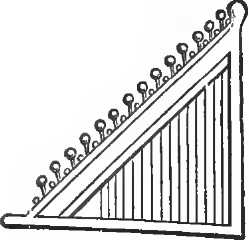 |
Many of the Irish monks of St. Gall were skilled harpers,
and it is on record that Tuathal (Tutilo), head-master of the music
school at that famous abbey, delighted in the cruit and the psaltery.
Many of his compositions have survived—including “Hodie Cantandus”
and “Omnipotens Genitor”, as we learn from Schubiger. He died in
extreme old age, on April 27th, 915.
The Anglo-Saxons were not slow to cultivate the Irish
cruit, which, as we have seen, was called hearpe by them. St. Bede
attests the popularity of this instrument in his time, and that
it was a custom to pass it from one to another at all feasts. The
beautiful drawing of a cruit in a tenth-century manuscript in the
British Museum (Vitellius, F. XI.) is of Irish origin, as Professor
Westwood admits, and is styled “an Irish crotta”, by Carl Engel.
All readers of English history are familiar with the story of Alfred
the Great (871-901) and his disguise as a harper whilst in the Isle
of Athelney. Even assuming that the story is mythical, the harp
must have been very popular with the Anglo-Saxons.
fig. 14.—HARP OF
NINTH
CENTURY. |
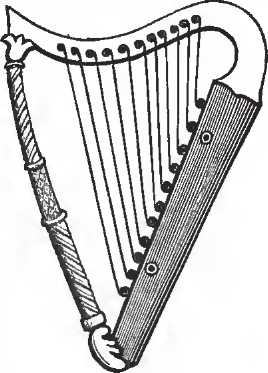 |
St. Dunstan, Archbishop of Canterbury (d. 988), stands
out pre-eminently in connection with the harp. Even allowing for
the traditional romance attaching to his history, St. Dunstan must
have been a proficient on the hearpe. The charge of sorcery brought
against him was owing to the his Aeolian harp :—
“By the desultory breeze caressed
It pours forth sweet upbraiding”.
His biographer tells us that the saint placed his harp
in a certain position, with the result that the wind, as it wafted
along the strings, caused the most delightful music. Nor are we
left to mere references as regards the cultivation of the harp in
pre-Norman days. In the British Museum and the University Library
of Cambridge, there are illustrations of tenth-century harps.
Among the distinguished Irish bards of the tenth century,
Flann mac Lonain was celebrated, and some of his poems are still
preserved; in one of which he describes a harper called Ilbrechtach,
of Slieve Aughty, near Kinalehin, Co. Galway. This harper is said
to have travelled with Mac Liag, the poet and historiographer of
Brian Boru, who was incensed at the minstrel’s praise of his predecessor
Mac Lonain.
Let us now turn our attention to Wales, which claims
a chapter all to itself.
III.
THE WELSH HARP
Ancient “British”music. “Morva Rhuddlan”. The Telyn,
or Welsh harp. Derivation of name. Eisteddfodau in the twelfth century.
Giraldus Cambrensis. The name Telyn used in Brittany and Cornwall.
Compass of early Welsh harps. The crwth trithant. Tunings of the
crwth.
From the third to the tenth century there was constant
intercourse between Wales and Ireland. Irish immigrants popularised
Celtic minstrelsy and developed a love of music among the Welsh.
Warton in his History of English Poetry says:—“There is sufficient
evidence to prove that the Welsh bards were early connected with
the Irish. Even so late as the eleventh century the practice continued
among the Welsh bards of receiving instruction in the bardic profession
(music and poetry) from Ireland”.
We can dismiss as quasi-fabulous the legends of the pre-Christian
Welsh harpers, and the “British” songs sung at the Court of King
Arthur, etc. The credulity of eighteenth century Welsh writers as
to some of their melodies going back to the sixth or seventh century
is simply marvellous. For example, the melody known as “Morva
Rhuddlan”, said to have been composed by the bard of Caradoc, after
the battle of Rhuddlan in 795, is an Irish air of the seventeenth
century, adapted by Moore to “Avenging and Bright”.
We have previously treated of the Welsh crwth, quite
a different instrument from the Irish cruit. One of the earliest
references to the crwth is in the Anomalous Laws, dating from the
twelfth or century, but the typical harp of Wales was known as the
Telyn. In all authentic Welsh documents the harp is invariably given
under the name Telyn. O'Curry derives this name from the buzzing
sound of the hair-strung harp. From the Welsh laws it appears that
the ordinary or lower-grade harpers of Wales in the twelfth century
were wont to play on harps strung with horse-hair, and that the
chief harper was entitled to a fine of twenty-four pence from each
minstrel who exchanged his hair-strung harp (telyn) for a gut-string
one.
Several entries in the Irish annals—from 950 to 1090—testify
to the exodus of Irish harpers to Wales, whilst it is absolutely
certain that Griffith ap Cynan was born of an Irish mother in Ireland
in 1065. At the Eisteddfod of Caerwys, in 1100, Welsh music
was codified under the direction of Malachy the Gwyddilian (the
Irishman), and twenty-four musical canons were adopted. One most
convincing fact adduced by Bunting, in 1809, is that the names
of the twenty-four measures of Welsh music, said to date from the
time of Prince Griffith ap Cynan, are written in Irish—a fact hinted
at by Jones.
In Dowling’s Annals of Ireland is recorded the death
of Prince Griffith, in 1137. It is said of him that “he led back
with him from Ireland harps, timpans, cruits, cytharae, and harpers”.
His son, Cadwallader ap Griffith, also went over to Ireland, and
brought back with him harpers.
Following on the Eisteddfod at Caerwys (1100), there
was another held by Cadogan, Prince of Powis, in the Castle of Cardigan,
at Christmastide of the year 1107. Of the successive meetings during half a century,
there are but scant particulars. However, in 1176, a famous Eisteddfod,
somewhat on the lines of the Irish Feis, was celebrated in Cardigan
Castle by Rhys ap Griffith, when harp competitions were a feature.
Giraldus Cambrensis, in the twelfth century, writes as
follows:—“Scotland and Wales, the former by reason of her derivation,
the latter from intercourse and affinity, seek with emulous endeavours
to imitate Ireland in music”. It is very remarkable that Giraldus
Cambrensis does not refer to the Welsh crwth in his enumeration
of instruments, though he notices its counterpart, the timpan, in
Ireland. His account makes it certain that the telyn and the cruit
were identical. He also adds that “the Irish were wont to use brass
wires for their harps in preference to those of gut”, implying,
of course, that his own Welsh harp had hair or gut. It is interesting,
too, to note that the Britons also call the harp telyn, as likewise
do the Cornish.
Again, as a further proof of the Irish origin of the
Welsh harp, we learn from Pennant that the telyn was a small instrument,
with only nine strings, Compass and only one row. He adds
that the single row of strings continued till after the Middle Ages,
when a double row succeeded. The learned Selden, in his notes to
Drayton’s Polyolbion, agrees to the view that Wales derived her
minstrelsy from Ireland. In the fourteenth century, when the
Irish clairsech, or large harp, was all the fashion, the Welsh harps
were made on the same lines. Jones describes a sixteenth-century
“Welsh” harp which had only one row of thirty-three strings, and
measured four feet nine inches in height; but, a Bunting observes,
it may well be called an “Irish” harp, to which, he assures us,
“it exactly answers in size and number of strings”.
Thus, Wales, as late as the fourteenth century, had no
distinctive harp save the telyn, which was in reality an Irish harp. The
older crwth, similar to the Irish cruit, was at this date transformed
into the instrument as described by the Hon. Daines Barrington,
in 1776, which he heard played by John Morgan in the Isle of Anglesey. What
was known as the crwth trithant, as pictured in manuscripts
of the eleventh century, was merely the three-stringed lyre. The
post-Reformation crwth was played as late as 1801, as stated by
Bingley in 1814, but we are in the dark as to the exact method of
tuning it.
According to Edward Jones (1752-1824), the later form
of crwth was tuned as follows:—
Tunings of the Crwth

He explains that the two outlying strings, plucked with
the thumb of the left hand, were G and g, while the four strings
on the finger-board, and played with the bow, were tuned c to C
and D to d, as printed above.
In size, the crwth was from 20 to 22’1/2 inches long,
the width being from 10 inches at the tail-piece to 8’1/2 inches
at the top, and the height of the sides two inches. The sound-holes
were round, having a diameter of a little over an inch. Bunting
says that the sculptured harp in Melrose Abbey (Scotland), dating
from the fourteenth century, is probably a crwth. For further information
as to the eighteenth-century crwth the reader is referred to Carl
Engel’s treatise, of which an excellent summary is given by Mr.
Paul Stoeving, in his Story of the Violin.
At the close of the fourteenth century the minstrels
helped to fan the spirit of resistance to English rule, and so powerful
were they in 1402 that an enactment was passed forbidding any one
to maintain rimers or minstrels.
IV.
“BRIAN BORU’S” HARP
Outline of the ‘Brian Boru’ legend. Examination of claims
in the light of history. Description of the O'Brien harp. Clue to
the real story. Probable date. Its wanderings. Restrung in the eighteenth
century. Presented to Trinity College, Dublin. Cast of it in South
Kensington Museum.
Brian Boru’s harp |
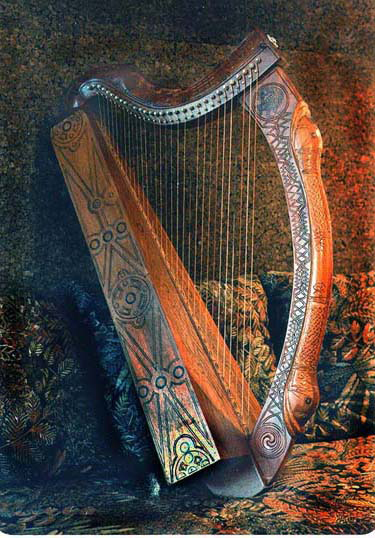 |
All visitors to Trinity College, Dublin, are shown Brian
Boru’s harp, it being supposed that this venerable instrument really
belonged to King Brian the hero of Clontarf. Perhaps it may be necessary
to explain that Brian Boru, recte Brian Borumha, was supreme monarch
of Ireland from 1003 to 1014. On April 23rd, 1014, he gave an overwhelming
defeat to the Danes at Clontarf, near Dublin, but was, unfortunately,
slain in the hour of victory. His harp and jewels were, as the story
goes, taken by his son Donogh, who, however, did not succeed to
the sovereignty of Ireland, Malachi, the former monarch, having
resumed the government.
Donogh O'Brien, after Clontarf, returned to his palace
at Kincora, but his right to the kingship of Thomond was disputed
by his elder brother, Tadhg. For years a fratricidal war continued,
which only ended with the death of Tadhg in 1023, whereupon Donogh
was acknowledged King of Munster. He had a troubled reign,
and at length was defeated, in 1061, at Slieve Crot, Co. Tipperary,
by Dermot mac Maelnambo, King of Leinster. After this, misfortune
followed on misfortune, and, in 1062, King Donogh, then over seventy
years of age, made a pilgrimage to Rome, and presented his crown
and sceptre to Pope Alexander II. Not alone did Donogh O'Brien (whose
wife was Driella, sister of Harold II, King of England) bring his
father’s crown andregalia to Rome, but, as is said, also brought
his father’s harp, which he bequeathed to the Pope. Anyhow, he died,
“after the victory of penance”, at the monastery of St. Stephen,
in Rome, in 1064, and the harp is said to have remained as one of
the treasures of the Vatican till 1521. In the latter year it was
given by Pope Leo X to King Henry VIII of England, at the same time
that the Pontiff conferred on the English monarch the title “Fidei
Defensor” (F.D. = Defender of the Faith), in recognition of his
Defence of the Seven Sacraments. Finally, in 1543, when Henry VIII
conferred the title of Earl of Clanrickarde on Mac William (Ulick)
de Burgo, he presented the Earl with this Irish harp, said to have
belonged to Brian Borumha. Vallancey says that the harp, after a
time, reverted to O'Brien, Earl of Thomond, and eventually became
the property of Ralph Ouseley of Limerick.
The above is a summary of the story as generally told;
but there is another version, written by Ralph Ouseley above mentioned,
dated October 22nd, 1783, to be found among the Egerton Manuscripts
in the British Museum:—
“This harp lay in the Vatican till Innocent XL, in 1678,
sent it as a token of his goodwill to Charles II, who had it deposited
in the Tower. Soon after this, the Earl of Clanrickarde, seeing it
among the curiosities, mentioned to the King that he knew an Irish
nobleman that Lwould probably give a limb of his estate for it (meaning
the Earl of Thomond), on which his Majesty immediately replied:
‘I make you a present of it; dispose of it as you please’. Lord
Clanrickarde brought it to Ireland, and Lord Thomond, being on his
travels, never was possessed of it. Some years after, it was purchased
by Lady Huxley for twenty rams and as many swine of English breed,
and bestowed by her on her son-in-law, Henry MacMahon of Clenagh,
in the County of Clare, who, about the year 1756, bestowed it to
Matt. MacNamara, of Limerick, Esq., Counsellor-at-Law, and some
years Recorder of that city, a most worthy, honoured, polite, and
hospitable gentleman. When given to Counsellor MacNamara, it had
silver strings and some more ornaments of plate than are now to
be seen; they were stolen or destroyed by the servants, or idle
people fiddling withal, as was also a letter from Mr. MacMahon,
giving a full and particular history of the said harp. It was left
as a token of esteem by Counsellor MacNamara, who died in 1774,
to Ralph Ouseley, of Dublin, an admirer of antiquity, and by him
presented, in 1781, to the Right Hon. W. Conyngham, whose taste
for the fine arts . . . deserves the highest encomiums”.
The latter account looks very circumstantial, but the
only part that can be accepted without hesitation is the history
of the instrument from about the year1720, when it came into the
possession of Henry MacMahon. Let us now briefly examine the claims.
We may at once state that an examination of the harp itself is conclusive
as against the supposed date of 1014. The workmanship is thirteenth
century, though Petrie inclined to the view that it was not made
before the second half of the fourteenth century.
There is no documentary evidence that Donogh
O'Brien brought any harp with him to Rome; nor yet has any one of
the Irish annalists alluded to King Brian Borumha as a harpist,
although they do tell us that he was a skilled chess-player. Again,
there is no proof that Pope Innocent XI, in 1678, sent any Irish
harp to King Charles II. Here let us give Dr. Petrie’s admirable
description of the Brian Boru’s harp:—
“From recent [1838] examination, it appears that this
harp had but one row of strings; that these were 30 in number, not
28, as was formerly supposed, 30 being the number of brass tuning-pins
and of corresponding string-holes. It is 32 inches high, and
of exquisite workmanship; the upright pillar is of oak, and the
sound-board of red sallow; the extremity of the fore-arm, or harmonic
curved bar, is capped in part with silver, extremely well wrought
and chiselled. It also contains a large crystal set in silver, under
which was another stone, now lost. The buttons [bosses], or ornamental
knobs, at the side of the curved bar are of silver. The string-holes
of the sound-board are neatly ornamented with escutcheons of bears
[? lions] carved and gilt. The four sounding-holes have also had
ornaments, probably of silver, as they have been the object of theft.
The bottom which it rests upon is a little broken, and the wood
very much decayed. The whole bears evidence of having been the work
of a very expert artist”.
Before adding any comment on this excellent description,
it may be well to quote an incident of the year 1216, which furnishes
a clue to the real origin of the Brian Boru harp.
In 1216 Finn O'Bradley, steward of the Prince of Tyrconnell
(Donal mor O'Donnell), was sent to collect tribute, but was slain,
in a fit of anger, by Muiredach O'Daly of Lisadil, Co. Sligo, a
famous Irish minstrel, who fled to Scotland, where he remained from
1217 to 1222. Whilst in Scotland, he wrote three celebrated
poems to O'Donnell, who allowed him to return to his native country,
and took him back into friendship. Meantime, Donnohadh Caribre O'Brien,
King of Thomond, sent his own harp—“the jewel of the O'Briens”—as
a pledge to Scotland for the ransom of the bard O'Daly. Accordingly,
the Irish minstrel was allowed to return home, but the harp was
detained in Scotland, where it remained for over eighty years.
Thus we can trace the history of a rare harp of the O'Briens,
sent to Scotland about the year 1221, as a pledge, by the valiant
King of Thomond, whose death took place on March 8th, 1243.
O'Daly’s Irish poems are preserved in Scotland in the
Dean of Lismore’s Book, the editor of which work says that O'Daly
“was the ancestor of the MacVurricks, bards to the MacDonalds of
Clanranald”—the bard himself being known in Ireland as albanach—that
is, “the Scotchman”—from his seven years’ residence in Scotland.
The O'Brien harp may fairly be dated as from about the
year 1220, and it was sent to Scotland in 1222. In 1228 or 1229,
Gillabride MacConmidhe, a famous Ulster bard, was commissioned by King
O'Brien to endeavour to ransom the much-prized instrument. In
response to this request, the bard composed the well-known “Ransom
Song”, but, alas! the lovely O'Brien harp would not be restored
for “whole flocks of sheep”, and so, as O'Curry remarks, it remained
in Scotland until King Edward I took it with him to Westminster
in 1307.
It lay at Westminster from 1307 until July 1st, 1543,
when Henry VIII presented it to the first Earl of Clanrickarde,
who, at his death in 1547, bequeathed it to his son Richard,
second Earl, husband of Margaret, daughter of O'Brien, Earl of Thomond.
Thus the harp reverted to its old owners about the middle of the
sixteenth century, as Lady Clanrickarde presented it to Conor, Earl
of Thomond.
In 1570 there was an Irish poem written in praise of
the “O'Brien Harp”, which had, during the enforced absence of its
owner, Conor, Earl of Thomond, been in temporary possession of a
certain O'Gilligan, a famous harper. The Irish bard describes it
as “a musical, fine-pointed [curved], speckled [ornamented] harp”,
and it is added: “though sweet in the hands of O'Gilligan, it was
sweeter far in the halls of O'Brien”.
By intermarriage, we find the O'Brien Harp in possession
of Henry MacMahon of Clenagh, Co. Clare, in 1750,. who, in 1756,
presented it to Matthew MacNamara, Recorder of Limerick.
Arthur O'Neill, the harpist, tells us that when he visited
Limerick in 1760, he had the honour of playing on the Brian Boru
harp, restored for the occasion at the cost of Mr. MacNamara. On
the death of the latter gentleman in 1774, the harp was bequeathed
to Ralph Ouseley, a musical amateur (grandfather of Sir Frederick
Gore Ouseley, Bart., Mus. Doc), and a noted antiquarian, who, in
1781, as before stated, presented it to the Right Hon. William Burton
Conyngham, P.C
Conyngham (who died in 1796) presented the O'Brien Harp
to Trinity College, where it has ever since remained. When
deposited in the College Museum it was in a deplorable condition,
as the harmonic curved bar was broken and fastened over the sound-box. Dr.
Robert Ball made a very careful restoration of the Dublin instrument,
supplying the lost portions from analogy, and lent it “as the oldest
known specimen of Irish harp” to the committee of the Dublin Exhibition,
in 1853.
| TRINITY COLLEGE HARP |
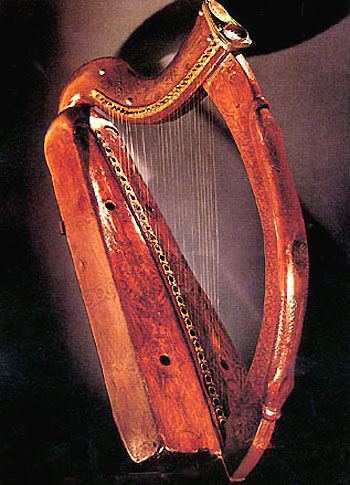 |
Curiously enough, one of the escutcheons, or silvered-bronze
badges, which Petrie describes as having been stolen, was found
in the Phoenix Park, Dublin, in 1876. From the armorial bearings
Petrie was led to believe that the harp belonged to an ecclesiastic
of the O'Neill family, and he dated the instrument as from the close
of the fourteenth century, but O'Curry’s view is convincing in favour
of the harp having belonged to Donnchadh Caribre O'Brien, King of
Thomond, in 1218.
Although the original harp of O'Brien is in the Library
of Trinity College, Dublin, there, is a good cast of it in the South
Kensington Museum, and a description of it is furnished by Carl
Engel in his admirable Catalogue. However, by far the most accurate
drawings of this Museum venerable instrument will be found in Mr.
R. Bruce Armstrong’s magnificent monograph on the Irish and Highland
Harps, a sumptuous quarto, issued in 1904, but now withdrawn from
circulation. Only 180 copies were printed. Mr. Armstrong enters
into the most minute particulars as to the harp itself and its Irish
ornamentation.

